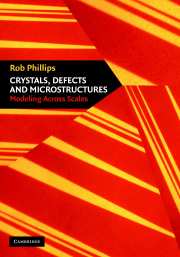Book contents
- Frontmatter
- Contents
- Preface
- Acknowledgements
- Notes on Units, Scales and Conventions
- Part One Thinking About the Material World
- Part two Energetics of Crystalline Solids
- Part three Geometric Structures in Solids: Defects and Microstructures
- 7 Point Defects in Solids
- 8 Line Defects in Solids
- 9 Wall Defects in Solids
- 10 Microstructure and its Evolution
- Part four Facing the Multiscale Challenge of Real Material Behavior
- References
- Index
7 - Point Defects in Solids
Published online by Cambridge University Press: 29 October 2009
- Frontmatter
- Contents
- Preface
- Acknowledgements
- Notes on Units, Scales and Conventions
- Part One Thinking About the Material World
- Part two Energetics of Crystalline Solids
- Part three Geometric Structures in Solids: Defects and Microstructures
- 7 Point Defects in Solids
- 8 Line Defects in Solids
- 9 Wall Defects in Solids
- 10 Microstructure and its Evolution
- Part four Facing the Multiscale Challenge of Real Material Behavior
- References
- Index
Summary
Point Defects and Material Response
This chapter is the first in a series that will make the case that many of the important features of real materials are dictated in large measure by the presence of defects. Whether one's interest is the electronic and optical behavior of semiconductors or the creep resistance of alloys at high temperatures, it is largely the nature of the defects that populate the material that will determine both its subsequent temporal evolution and response to external stimuli of all sorts (e.g. stresses, electric fields, etc.). For the most part, we will not undertake an analysis of the widespread electronic implications of such defects. Rather, our primary charter will be to investigate the ways in which point, line and wall defects impact the thermomechanical properties of materials.
Though we will later make the case (see chap. 11) that many properties of materials involve a complex interplay of point, line and wall defects, our initial foray into considering such defects will be carried out using dimensionality as the central organizing principle. In many instances, it is convenient to organize defects on the basis of their underlying dimensionality, with point defects characterized mathematically through their vanishing spatial extent, line defects such as dislocations sharing some of the mathematical features of space curves, and surfaces, grain boundaries and other wall defects being thought of as mathematical surfaces. Indeed, one of the interesting physics questions we will ask about such defects is the extent to which such dimensional classifications jibe with the properties of the defects themselves.
- Type
- Chapter
- Information
- Crystals, Defects and MicrostructuresModeling Across Scales, pp. 311 - 361Publisher: Cambridge University PressPrint publication year: 2001
- 2
- Cited by

